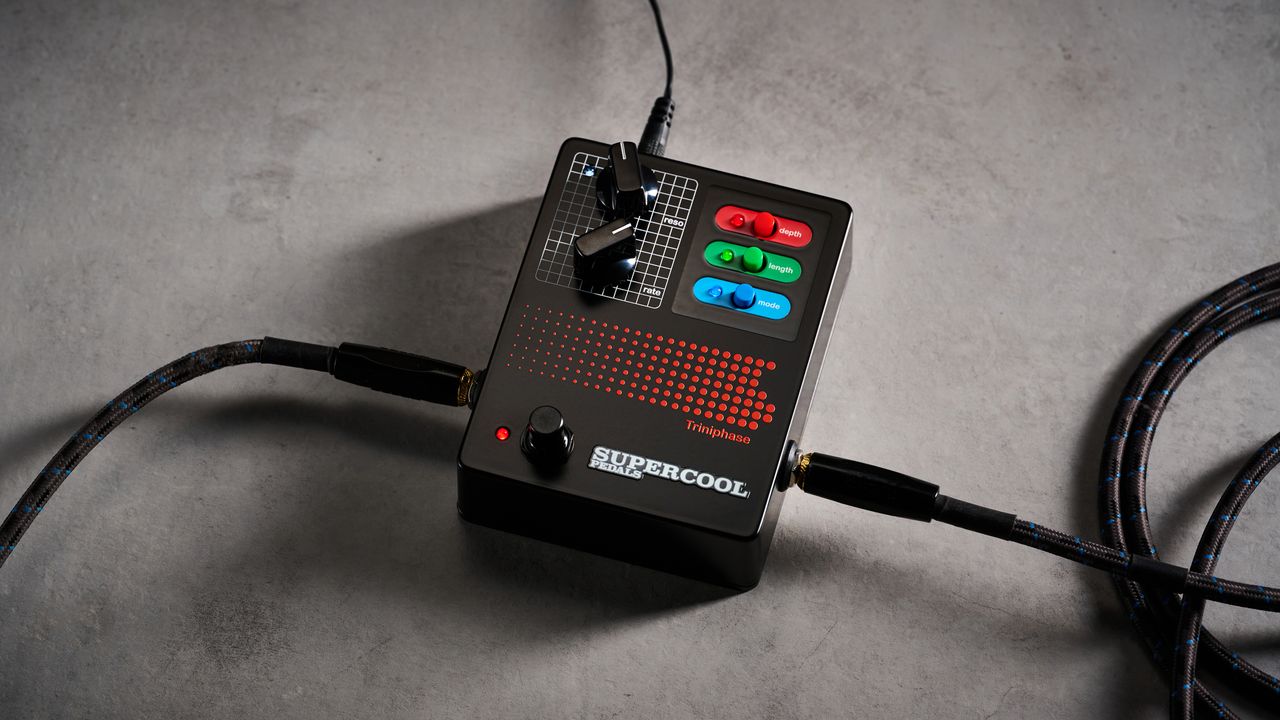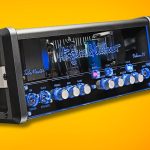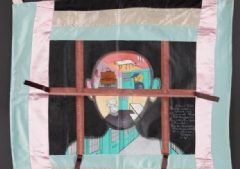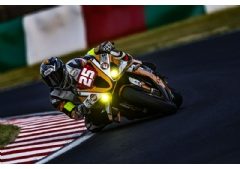
“The strength of the Triniphase is how much it encourages experimentation”: Supercool Pedals Triniphase review
Guitar World Verdict
Much of the attraction of boutique pedals is the way they look, the whims and moods of their designers, and that’s the strongest selling point of the Triniphase. It’s got a great vibe and mojo to it, backed up by great sounds. If you want a good-looking looking, Swiss Army phaser, you could do much worse.
Pros
+Excellent sounding phaser with strong mojo.
+Features 4- and 8-stage modes, with additional voice options.
+Competitively priced.
Cons
-Like a lot of options out there, it’s good for a few go-to sounds but it’s a pedal that rewards enthusiastic phaser fans.
You can trust Guitar World
Our expert reviewers spend hours testing and comparing guitar products so you can choose the best for you. Find out more about how we test.
What is it?
(Image credit: Matt Lincoln / Future)The Triniphase is the tenth pedal from boutique builder Jamie Muir of Canada’s Supercool Pedals. Building on its previous distortions, boosts and fuzzes, the Triniphase feels a step up, both in sounds and presentation.
It’s an all-analog OTA (Operational Transconductance Amplifier) phaser pedal based on the legendary Ross Phaser, but with additional functions. The Ross only had two knobs, and that simplicity is maintained, albeit with the addition of six voicing shifts controlled by three toggle switches.
Specs
(Image credit: Supercool Pedals)Launch price: $219Type: Analog PhaserMade: CanadaControls: Reso, Rate, Depth, Length, ModeFeatures: 4-stage phaser, 8-stage phaserConnectivity: Input, Output, PowerBypass: TruePower: 9V DC Centre-negativeDimensions: 94 x 38 x 120 mmWeight: 350 gramsContact: Supercool PedalsBuild quality
(Image credit: Matt Lincoln / Future)Build quality rating: ★★★★½
The Triniphase is solid and intuitively laid out. As usual with mini toggle switches on the front panel, I’m wary of the damage a spilled beer could do, but that’s probably being over-paranoid.
My main concern, on reflection, would be that these kinds of small switches often fail at some point. Still, I trust that Supercool has thought of this and used robust parts.
The inside is a neat SMD layout, and it’s pleasing to see an easter egg on the board. Finally, it’s a minor point, but the anodized black footswitch on the front panel is a nice touch on a pedal Supercool has stated is inspired in aesthetic (and name) by Sony’s Trinitron CRTs.
Usability
(Image credit: Matt Lincoln / Future)Usability rating: ★★★★★
It’s a pedal that rewards tweaking, poking around, and seeing what happens when settings are changed
In spite of the number of different voicings and sounds in the pedal, it’s a straightforward unit, thanks to some clever design. On the top left, there’s an LED that shows the rate, while the two pots on the front panel control resonance, or feedback, and rate. To the right, different voices come from the depth, length and mode toggle switches, which each have two settings, indicated by LEDs.
It’s a pedal that rewards tweaking, poking around, and seeing what happens when settings are changed. Though the range of the controls is easy to get good results from, the pedal’s designer said that he wanted crazy sounds when maxed out, and that’s true too. At more extreme settings, there’s pitch modulation and strange ring-mod artifacts.
Sounds
(Image credit: Matt Lincoln / Future)Sounds rating: ★★★★★
Testing with a Gibson Les Paul with relatively hot humbuckers, I instantly dialled in a solid vintage phase sound. Bridge pickups feel like they give filters more to chew on, and that instinct proved correct here, especially with a fuzz in front.
The red depth control toggles between 4-stage (with the light on), and 8-stage (with the light off). The 4-stage mode is reminiscent of classic phasers like the Small Stone, MXR Phase 90, and the Ross, while the 8-stage has a deeper sweep, and a more modern voicing. Both handled whatever combination of guitars and pickup I threw at them, though the huge sweep of the 8-stage may be an acquired taste for some.
(Image credit: Matt Lincoln / Future)That’s where the green toggle, length, comes in. It controls the waveform. Full length sweep (with the light on) is a classic phase tone, while in half-length mode (light off) treble frequencies are emphasised. By design, the half-length mode pairs well with the 8-stage setting. With the rate pushed up, there’s decent vibrato and Uni-Vibe style sounds to be had. Even used as a straightforward phaser, the half-length mode tames the 8-stage enough for players not wanting a disorientatingly lysergic tone.
In my experience, phasers and modulation are often ‘set and forget’ in a band context, and it’s why all-in-one digital modulation boxes are so attractive. The strength of the Triniphase is how much it encourages experimentation, but I suspect that it would still end up set to one or two tones used in a setlist too.
Verdict
(Image credit: Matt Lincoln / Future)An interesting feature set, great sounds and unique looks
It’s a sweeping generalisation, but you usually only see two types of phasers on pedalboards – vintage voiced and digital. Anything outside of these categories is a bit of an oddity, because additional controls and features on top of the vintage-style boxes can only add so much. Still, where there’s a niche, there’s a boutique pedal, and the Triniphase slots in here with an interesting feature set, great sounds and unique looks.
Guitar World verdict: Much of the attraction of boutique pedals is the way they look, the whims and moods of their designers, and that’s the strongest selling point of the Triniphase. It’s got a great vibe and mojo to it, backed up by great sounds. If you want a good-looking, Swiss Army phaser, you could do much worse.
Swipe to scroll horizontally
Ratings scorecardTest
Results
Score
Build quality
Good looks and build here – as long as those mini toggle switches hold up long-term.
★★★★½
Usability
An excellent combo of intuitive controls for easy recall that encourages deeper experimentation.
★★★★★
Sounds
Great tones for those who want more traditional phaser sounds, but scope for much more here.
★★★★★
Overall
Another superb pedal from Supercool that existing phaser fans and those looking to bring the effect to their ‘boards should be rewarded by.
★★★★½
Also try
MXR Phase 90 – $99.99/£99.99/€100
Now hitting its 50th anniversary, the Phase 90 is still a go-to phaser pedal. There are multiple versions based on it out there, including micro enclosure variants and the switchable EVH graphic model and though there are differences between each, all have that killer vintage phase tone.
Read more: Why the Phase 90 is a classic pedal
EHX Small Stone – $83.50/£69.99/€63
Affordable as ever, the Small Stone remains the benchmark for vintage voiced phasers. Underestimate it at your peril.
Strymon Mobius – $449/£399/€444
If you need flexibility, MIDI control and an array of other modulation options then look no further than this workstation.
Read more: Strymon Mobius review
Hands-on videosSupercool Pedals
Introducing the Triniphase by Supercool Pedals – YouTube
Watch On
Pedal Of The Day
I’m Going Through a Phase – Supercool Pedals Triniphase Multi-Stage Phaser – YouTube
Watch On
B’s Music Shop
Trippy, Sweeping, Wild – Triniphase Delivers Analog Bliss! – YouTube
Watch On
Best phaser pedals
Alex Lynham is a gear obsessive who’s been collecting and building modern and vintage equipment since he got his first Saturday job. Besides reviewing countless pedals for Total Guitar, he’s written guides on how to build your first pedal, how to build a tube amp from a kit, and briefly went viral when he released a glitch delay pedal, the Atom Smasher.
You must confirm your public display name before commenting
Please logout and then login again, you will then be prompted to enter your display name.











